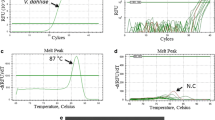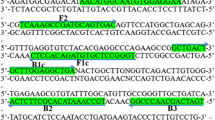Abstract
The rapid and reliable identification and quantification of pathogens is essential for the management of economically important plant diseases. Fusarium oxysporum f. sp. cucumerinum is the soil borne fungus responsible for Fusarium vascular wilt of cucumber. In this study, we report the development of a specific and reliable real-time quantitative PCR assay and the development of an ultra-sensitive diagnostic pseudo-nested PCR assay. The capacity of the PCR assays to accurately identify and quantify Fusarium oxysporum f. sp. cucumerinum was experimentally tested by the development of standard curves from serial dilutions of copy numbers in a range of complex environmental DNA samples. The amplification efficiency, sensitivity and reproducibility of the qPCR assays were not significantly affected by the presence of any of the non-target background DNA tested. In quantitative real-time PCR, as few as 100 copies could be reliably quantified, and in simple and pseudo-nested PCR as little as 10 pg and 10 fg, respectively, could be detected. This rapid and sensitive qPCR method can be used to facilitate investigations into plant–pathogen interactions, epidemiology, and disease management practices.



Similar content being viewed by others
References
Abdullah, S. K., & Ismail, A. L. S. (1976). Studies of Fusarium oxysporum f. sp. lycopersici wilt of tomatoes in Iraq Part 2. Nonsusceptible hosts as carriers of wilt Fusaria in Basrah area. Proceedings of the Indian National Science Academy - Part B, 42, 182–193.
Ahn, I. P., Chung, H. S., & Lee, Y. H. (1998). Vegetative compatibility groups and pathogenicity among isolates of Fusarium oxysporum f. sp. cucumerinum. Plant Disease, 82, 244–246.
Alabouvette, C. (1990). Biological control of Fusarium wilt pathogens in suppressive soils. In D. Hornby (Ed.), Biological control of soil-borne plant pathogens (pp. 27–43). Wallingford: CAB International.
Armstrong, G. M., & Armstrong, J. K. (1981). Formae speciales and races of Fusarium oxysporum causing wilt diseases. In P. E. Nelson, T. A. Toussoun, & R. J. Cook (Eds.), Fusarium: Disease, biology, and taxonomy (pp. 391–399). University Park: Pennsylvania State University Press.
Baayen, R. P., O’Donnell, K., Bonants, P. J. M., Cigelnik, E., Kroon, L. P. N. M., Roebroeck, E. J. A., et al. (2000). Gene genealogies and AFLP analyses in the Fusarium oxysporum complex identify monophyletic and nonmonophyletic formae speciales causing wilt and rot disease. Phytopathology, 90, 891–900.
Bogale, M., Wingfield, B. D., Wingfield, M. J., & Steenkamp, E. T. (2006). Characterization of Fusarium oxysporum isolates from Ethiopia using AFLP, SSR, and DNA sequence analyses. Fungal Diversity, 23, 51–66.
Burgess, L. W., Summerell, B. A., Bullock, S., Gott, K. P., & Backhouse, D. (1994) Laboratory manual for fusarium research, 3rd edition. Department of Crop Science, University of Sydney/Royal Botanic Gardens.
Capote, N., Pastrana, A. M., Aguado, A., & Sánchez-Torres, P. (2012) Molecular tools for detection of plant pathogenic fungi and fungicide resistance. In C. J. Cumagun (Ed.), Plant pathology (pp. 151–202). InTech.
Champlot, S., Berthelot, C., Pruvost, M. I., Bennett, E. A., Grange, T., & Geigl, E. M. (2010). An efficient multistrategy DNA decontamination procedure of PCR reagents for hypersensitive PCR applications. PLoS One, 9, 1–15.
Cramer, R. A., Byrne, P. F., Brick, M. A., Panella, L., Wickliffe, E., & Schwartz, H. F. (2003). Characterization of Fusarium oxysporum isolates from common bean and sugar beet using pathogenicity assays and randomamplified polymorphic DNA markers. Journal of Phytopathology, 151, 352–360.
Di Pietro, A., Madrid, M. P., Caracuel, Z., Delgado-Jarana, J., & Roncero, M. I. G. (2003). Fusarium oxysporum: exploring the molecular arsenal of a vascular wilt fungus. Molecular Plant Pathology, 4, 315–326.
Dineen, S. M., Aranda, R. I., Anders, D. L., & Robertson, J. M. (2010). An evaluation of commercial DNA extraction kits for the isolation of bacterial spore DNA from soil. Journal of Applied Microbiology, 109, 1886–1896.
El-Hamalawi, Z. A. (2008). Acquisition, retention and dispersal of soilborne plant pathogenic fungi by fungus gnats and moth flies. Annals of Applied Biology, 153, 195–203.
Elmer, W. H. (2008). Preventing spread of Fusarium wilt of Hiemalis begonias in the greenhouse. Crop Protection, 27, 1078–1083.
Filion, M., St-Arnaud, M., & Jabaji-Hare, S. H. (2003). Quantification of Fusarium solani f. sp. phaseoli in mycorrhizal bean plants and surrounding mycorrhizosphere soil using real-time polymerase chain reaction and direct isolations on selective media. Phytopathology, 93, 229–235.
Glass, N. L., & Kuldau, G. A. (1992). Mating type and vegetative incompatibility in filamentous ascomycetes. Annual Review of Phytopathology, 30, 201–224.
Hayden, K. J., Rizzo, D., Tse, J., & Garbelotto, M. (2004). Detection and quantification of Phytophthora ramorum from California forests using a real-time polymerase chain reaction assay. Phytopathology, 94, 1075–1083.
Inami, K. C., Yoshioka, C., Hirano, Y., Kawabe, M., Tsushima, S., Teraoka, T., et al. (2010). Real-time PCR for differential determination of the tomato wilt fungus, Fusarium oxysporum f. sp. lycopersici, and its races. Journal of General Plant Pathology, 76, 116–121.
Jenkins, S. F., & Wehner, T. C. (1983). Occurrence of Fusarium oxysporum f. sp. cucumerinum on greenhouse-grown Cucumis sativus seed stocks in North Carolina. Plant Disease, 67, 1024–1025.
Jimenez-Fernandez, D., Montes-Borrego, M., Navas-Cortes, J. A., Jimenez-Diaz, R. M., & Landa, B. B. (2010). Identification and quantification of Fusarium oxysporum in planta and soil by means of an improved specific and quantitative PCR assay. Applied Soil Ecology, 46, 372–382.
Katan, J. (1971). Symptomless carriers of the tomato Fusarium wilt pathogen. Phytopathology, 61, 1213–1217.
Kistler, H. C. (1997). Genetic diversity in the plant–pathogenic fungus Fusarium oxysporum. Phytopathology, 87, 474–479.
L’Haridon, F., Aimé, S., Duplessis, S., Alabouvette, C., Steinberg, C., & Olivain, C. (2011). Isolation of differentially expressed genes during interactions between tomato cells and a protective or a non-protective strain of Fusarium oxysporum. Physiological and Molecular Plant Pathology, 76, 9–19.
Lievens, B., Brouwer, M., Vanachter, A. C. R. C., Cammue, B. P. A., & Thomma, B. P. H. J. (2006). Real-time PCR for detection and quantification of fungal and oomycete tomato pathogens in plant and soil samples. Plant Science, 171, 155–165.
Lievens, B., Claes, L., Vakalounakis, D. J., Vanachter, A. C. R., & Thomma, B. (2007). A robust identification and detection assay to discriminate the cucumber pathogens Fusarium oxysporum f. sp. cucumerinum and f. sp. radicis-cucumerinum. Environmental Microbiology, 9, 2145–2161.
Martínez, R., Aguilar, M. I., Guirado, M. L., Álvarez, A., & Gómez, J. (2003). First report of fusarium wilt of cucumber caused by Fusarium oxysporum in Spain. Plant Pathology, 52, 410.
Martyn, R. D. (1996). Fusarium wilt of cucumber. In T. A. Zitter, D. L. Hopkins, & C. E. Thomas (Eds.), Compendium of cucurbit diseases (pp. 15–16). St. Paul: The America Phytopathological Society Press.
Nelson, P. E., Toussoun, T. A., & Marasas, W. F. O. (1983). Fusarium species: An illustrated manual for identification. University Park: Pennsylvania State University Press.
Neshev, G. (2008). Major soil-borne phytopathogens on tomato and cucumber in Bulgaria, and methods for their management. Rome: Food and Agriculture Organization of the United Nations (FAO).
O’Donnell, K., Kistler, H. C., Cigelnik, E., & Ploetz, R. C. (1998). Multiple evolutionary origins of the fungus causing Panama disease of banana: concordant evidence from nuclear and mitochondrial gene genealogies. Proceedings of the National Academy of Sciences of the United States of America, 95, 2044–2049.
Owen, J. H. (1955). Fusarium wilt of cucumber. Phytopathology, 45, 435–439.
Owen, J. H. (1956). Cucumber wilt, caused by Fusarium oxysporum f. sp. cucumerinum N.F. Phytopathology, 46, 153–157.
Pasquali, M., Marena, L., Fiora, E., Piatti, P., Gullino, M. L., & Garibaldi, A. (2004). Real time polymerase chain reaction for identification of a highly pathogenic group of Fusarium oxysporum f. sp. chrysanthemi on Argyranthemum frutescens. Journal of Plant Pathology, 86, 53–59.
Pasquali, M., Piatti, P., Gullino, M. L., & Garibaldi, A. (2006). Development of a real-time polymerase chain reaction for the detection of Fusarium oxysporum f. sp. basilica from basil seed and roots. Journal of Phytopathology, 154, 632–636.
Paulitz, T. C., Park, C. S., & Baker, R. (1987). Biological control of Fusarium wilt of cucumber with non-pathogenic isolates of Fusarium oxysporum. Canadian Journal of Microbiology, 33, 349–353.
Porteous, A. L., & Armstrong, J. L. (1991). Recovery of bulk DNA from soil by a rapid, small-scale extraction method. Current Microbiology, 22, 345–348.
Postma, J., & Rattink, H. (1992). Biological control of Fusarium wilt of carnation with a non-pathogenic isolate of Fusarium oxysporum. Canadian Journal of Botany, 70, 1199–1205.
Rep, M., & Kistler, H. C. (2010). The genomic organization of plant pathogenicity in Fusarium species. Current Opinion in Plant Biology, 13, 420–426.
Rozen, S., & Skaletsky, H. (2000). Primer3 on the www for general users and for biologist programmers. In S. Krawetz & S. Misener (Eds.), Bioinformatics methods and protocols: Methods in molecular biology (pp. 365–386). Totowa: Humana Press.
Skovgaard, K., Nirenberg, H. I., O’Donnell, K., & Rosendahl, S. (2001). Evolution of Fusarium oxysporum f. sp. vasinfectum races inferred from multigene genealogies. Phytopathology, 91, 1231–1237.
Tsai, Y. L., & Olson, B. H. (1992). Detection of low numbers of bacterial cells in soils and sediments by polymerase chain reaction. Applied and Environmental Microbiology, 58, 754–757.
Vakalounakis, D. J. (1996). Root and stem rot of cucumber caused by Fusarium oxysporum f. sp. radicis-cucumerinum. Plant Disease, 80, 313–316.
Vakalounakis, D. J., & Fragkiadakis, G. A. (1999). Genetic diversity of Fusarium oxysporum isolates from cucumber: differentiation by pathogenicity, vegetative compatibility, and RAPD fingerprinting. Phytopathology, 89, 161–168.
Wicks, T. J., Volle, D., & Baker, B. T. (1978). The effect of soil fumigation and fowl manure on populations of Fusarium oxysporum f. sp. cucumerinum in greenhouse soil and on the incidence of cucumber wilt. Agricultural Record, 5, 5.
Zambounis, A. G., Paplomatas, E., & Tsaftaris, A. S. (2007). Intergenic spacer—RFLP analysis and direct quantification of Australian Fusarium oxysporum f. sp. vasinfectum isolates from soil and infected cotton tissues. Plant Disease, 91, 1564–1573.
Acknowledgments
The authors would like to acknowledge and thank the Royal Botanic Gardens and Department of Primary Industries NSW for access and use of their Fusarium Collections and Dr. Neil Wilson, Faculty of Agriculture and Environment, University of Sydney, for technical assistance.
Author information
Authors and Affiliations
Corresponding author
Rights and permissions
About this article
Cite this article
Scarlett, K., Tesoriero, L., Daniel, R. et al. Detection and quantification of Fusarium oxysporum f. sp. cucumerinum in environmental samples using a specific quantitative PCR assay. Eur J Plant Pathol 137, 315–324 (2013). https://doi.org/10.1007/s10658-013-0244-1
Accepted:
Published:
Issue Date:
DOI: https://doi.org/10.1007/s10658-013-0244-1




